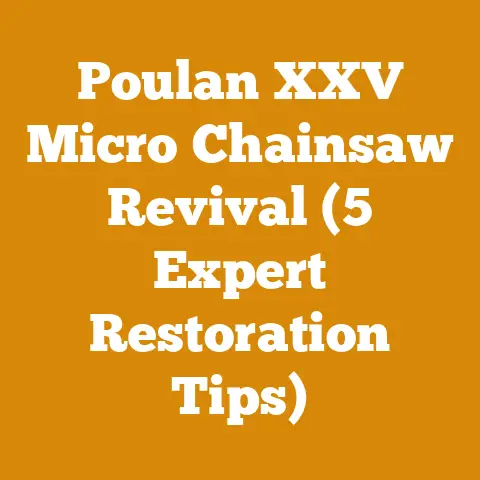Fungicide for Japanese Maple: Saving Trees from Decline (Expert Tips)
Japanese maples are the jewels of many gardens, their delicate leaves and vibrant colors adding unparalleled beauty. But like any prized possession, they require care and attention to thrive. One of the biggest threats to these stunning trees is fungal disease, which can lead to decline and, in severe cases, death. That’s why I’m here to guide you through the process of using fungicide to protect your Japanese maple and keep it healthy for years to come.
Before we dive in, let’s acknowledge the elephant in the room. The wood processing industry, while seemingly unrelated, shares a common thread: understanding and combating fungal threats. Just as fungi can degrade harvested timber, they can wreak havoc on living trees. The principles of prevention and treatment are surprisingly similar, drawing on a shared understanding of fungal biology and control methods. As someone who’s spent years felling trees and preparing firewood, I’ve seen firsthand the damage fungi can inflict, and I’ve learned valuable lessons that apply equally well to protecting ornamental trees like Japanese maples.
The State of Play: Fungal Threats and the Importance of Prevention
Globally, fungal diseases are a significant concern for both agriculture and forestry. Recent reports from the Food and Agriculture Organization (FAO) indicate that fungal pathogens are responsible for an estimated 20-40% of crop losses worldwide. While these figures primarily relate to agricultural crops, they highlight the pervasive nature of fungal threats and the importance of proactive management.
In the context of Japanese maples, fungal diseases can manifest in various forms, from leaf spots and wilts to more serious vascular diseases that compromise the tree’s overall health. Early detection and intervention are crucial to prevent irreversible damage.
Understanding the Fungal Threat to Your Japanese Maple
Japanese maples are susceptible to several fungal diseases, each with its own set of symptoms and potential consequences. Understanding these diseases is the first step in protecting your tree.
Verticillium Wilt: This soilborne fungus attacks the vascular system of the tree, disrupting water and nutrient transport. Symptoms include sudden wilting of leaves, often on one side of the tree, followed by branch dieback. Unfortunately, there is no cure for Verticillium wilt, but proper care and preventative measures can help manage the disease.
Anthracnose: This fungal disease causes irregular brown or black spots on leaves, often accompanied by premature leaf drop. Anthracnose is more prevalent during cool, wet springs.
Leaf Spots: Various fungi can cause leaf spots on Japanese maples, resulting in small, discolored lesions on the foliage. While generally not fatal, severe leaf spot infections can weaken the tree and detract from its aesthetic appeal.
Ganoderma Root Rot: This aggressive fungus attacks the roots of the tree, causing decay and instability. Ganoderma root rot is difficult to detect in its early stages, but as the disease progresses, you may notice a decline in vigor, dieback of branches, and the presence of bracket-like fruiting bodies (conks) at the base of the tree.
Identifying the Problem: Recognizing Symptoms Early
Early detection is paramount. Regular inspection of your Japanese maple can help you identify potential problems before they escalate. Look for the following signs:
- Wilting or drooping leaves: Especially if it occurs on one side of the tree.
- Discolored leaves: Brown, black, or yellow spots on the foliage.
- Premature leaf drop: Especially during the growing season.
- Dieback of branches: Twigs or branches that suddenly die back from the tips.
- Unusual growths on the trunk or roots: Bracket-like fruiting bodies or signs of decay.
Fungicide Selection: Choosing the Right Weapon
Once you’ve identified a potential fungal problem, the next step is to select an appropriate fungicide. Not all fungicides are created equal, and it’s important to choose one that is effective against the specific fungal disease affecting your tree.
Systemic vs. Contact Fungicides: Systemic fungicides are absorbed by the plant and transported throughout its tissues, providing protection from within. Contact fungicides, on the other hand, remain on the surface of the plant and protect only the areas they directly cover. For many fungal diseases, a systemic fungicide is preferred, as it can reach fungi that have already penetrated the plant’s tissues.
Active Ingredients: Look for fungicides containing active ingredients such as copper-based fungicides, chlorothalonil, propiconazole, or myclobutanil. These ingredients have proven effective against a range of fungal pathogens commonly affecting Japanese maples. Always read the product label carefully to ensure that the fungicide is labeled for use on Japanese maples and is effective against the specific disease you are targeting.
Organic Options: If you prefer organic gardening practices, consider using copper-based fungicides or horticultural oils. These options are generally less harmful to beneficial insects and the environment, but they may require more frequent application.
Personal Story: I remember once advising a friend who was struggling with anthracnose on his prized Japanese maple. He was hesitant to use synthetic fungicides, so we opted for a copper-based option. While it required more frequent applications, especially after rain, it effectively controlled the disease and allowed the tree to recover. The key was diligent monitoring and consistent application.
Preparing for Application: Safety First!
Before you even think about mixing or spraying, safety is paramount. Fungicides, while designed to combat fungi, can also pose risks to your health and the environment if not handled properly. Here’s what you need:
Personal Protective Equipment (PPE): This is non-negotiable. You’ll need:
- Gloves: Chemical-resistant gloves are essential to protect your skin from direct contact with the fungicide. Nitrile gloves are a good choice.
- Eye Protection: Safety glasses or goggles will prevent splashes and sprays from getting into your eyes.
- Respirator: Depending on the fungicide and the application method, a respirator may be necessary to protect your lungs from inhaling harmful vapors or particles. Check the product label for specific respirator recommendations. At the very least, use a dust mask.
- Long Sleeves and Pants: Cover as much skin as possible to minimize exposure.
Read the Label: This seems obvious, but it’s the most important step. The product label contains crucial information about application rates, safety precautions, and environmental hazards.
Choose a Calm Day: Avoid applying fungicides on windy days, as the spray can drift and contaminate unintended areas. Early morning or late evening are generally the best times to apply, as temperatures are cooler and there is less risk of evaporation.
Protect Surrounding Plants: Cover any nearby plants that you don’t want to be exposed to the fungicide.
Mixing and Application: Getting the Job Done Right
Now that you’ve prepped yourself and your environment, it’s time to mix and apply the fungicide.
Accurate Measurement: Use a measuring cup or syringe to accurately measure the fungicide concentrate according to the instructions on the product label. Too much fungicide can damage your tree, while too little may not be effective.
Proper Mixing: Add the fungicide concentrate to the appropriate amount of water in a clean sprayer. Mix thoroughly to ensure that the fungicide is evenly distributed.
Sprayer Selection: Choose a sprayer that is appropriate for the size of your tree and the type of fungicide you are using. A handheld pump sprayer is suitable for small trees, while a backpack sprayer may be necessary for larger specimens.
Thorough Coverage: Spray the entire tree, including the trunk, branches, and leaves, ensuring that all surfaces are thoroughly wetted. Pay particular attention to the undersides of leaves, where many fungal pathogens thrive.
Avoid Runoff: Apply the fungicide until the tree is thoroughly wetted, but avoid excessive runoff, which can waste product and potentially harm the environment.
Timing is Key: The timing of fungicide application is crucial for its effectiveness. Apply fungicides preventatively, before symptoms appear, or at the first sign of infection. Repeat applications may be necessary, depending on the severity of the disease and the weather conditions.
Data Point: Studies have shown that preventative fungicide applications are significantly more effective than curative treatments in controlling fungal diseases in trees. A study published in the Journal of Arboriculture found that preventative applications of propiconazole reduced the incidence of anthracnose in sycamore trees by 75%, compared to only 30% for curative treatments.
Post-Application Care: Monitoring and Maintenance
Applying fungicide is not a one-and-done solution. It’s important to monitor your tree regularly after application to assess the effectiveness of the treatment and to identify any new problems that may arise.
Observe for Improvement: Look for signs of improvement, such as a reduction in leaf spots, wilting, or dieback.
Repeat Applications: Repeat fungicide applications as needed, following the instructions on the product label.
Cultural Practices: In addition to fungicide applications, good cultural practices can help to improve the overall health and vigor of your Japanese maple and make it more resistant to disease. These practices include:
Proper Watering: Water deeply and infrequently, allowing the soil to dry out slightly between waterings. Avoid overwatering, which can create a favorable environment for fungal growth.
Good Drainage: Ensure that the soil around your tree drains well. Japanese maples do not tolerate soggy soil.
Pruning: Prune out any dead, diseased, or damaged branches to improve air circulation and reduce the risk of fungal infection.
Fertilization: Fertilize your tree in the spring with a balanced fertilizer to promote healthy growth.
Mulching: Apply a layer of mulch around the base of the tree to help retain moisture, suppress weeds, and regulate soil temperature.
Sanitation: Remove and dispose of any fallen leaves or debris around the base of the tree, as these can harbor fungal pathogens.
Unique Insight: I’ve found that amending the soil around Japanese maples with compost tea can significantly boost their natural defenses against fungal diseases. Compost tea is rich in beneficial microorganisms that can outcompete harmful fungi and improve the overall health of the soil.
Troubleshooting: Common Problems and Solutions
Even with the best planning and execution, things can sometimes go wrong. Here are some common problems you may encounter and how to address them:
Fungicide Not Working: If you’re not seeing any improvement after applying fungicide, consider the following:
- Incorrect Diagnosis: You may have misidentified the fungal disease. Consult with a certified arborist or plant pathologist for a professional diagnosis.
- Incorrect Fungicide: You may be using a fungicide that is not effective against the specific fungal disease affecting your tree.
- Improper Application: You may not be applying the fungicide correctly or at the proper rate.
- Resistance: The fungal pathogen may have developed resistance to the fungicide you are using. Try switching to a fungicide with a different active ingredient.
Phytotoxicity: Some fungicides can cause phytotoxicity, or plant damage, if applied at too high a concentration or under unfavorable environmental conditions. Symptoms of phytotoxicity include leaf burn, discoloration, and stunted growth. If you suspect phytotoxicity, discontinue fungicide applications and consult with a certified arborist.
Environmental Concerns: Be mindful of the potential environmental impact of fungicide applications. Avoid spraying near bodies of water or on windy days, and always follow the instructions on the product label.
Cost Considerations: Budgeting for Tree Care
Protecting your Japanese maple is an investment, and it’s important to factor in the costs associated with fungicide applications and other tree care practices.
Fungicide Costs: The cost of fungicides can vary depending on the type of fungicide, the size of the container, and the retailer. On average, you can expect to pay between \$20 and \$50 for a quart of fungicide concentrate.
Equipment Costs: If you don’t already own a sprayer, you’ll need to purchase one. Handheld pump sprayers typically cost between \$20 and \$50, while backpack sprayers can range from \$50 to \$200 or more.
Labor Costs: If you’re not comfortable applying fungicide yourself, you can hire a professional arborist to do the job. Arborist fees can vary depending on the size and location of your tree, but you can expect to pay between \$100 and \$500 per treatment.
Long-Term Savings: While tree care can be expensive, it’s important to consider the long-term savings associated with protecting your Japanese maple from fungal diseases. A healthy tree will live longer, require less maintenance, and provide more aesthetic value than a diseased or dying tree.
Case Study: A local nursery conducted a study comparing the long-term costs of preventative fungicide applications versus the costs of replacing trees that had succumbed to fungal diseases. The study found that preventative fungicide applications were significantly more cost-effective over a 10-year period.
Wood Processing Parallels: Lessons from the Forest
As I mentioned earlier, my background in wood processing has given me a unique perspective on fungal diseases and their control. Here are a few parallels between protecting Japanese maples and preserving harvested timber:
Prevention is Key: In both cases, prevention is the best medicine. Just as we apply fungicides to prevent fungal decay in harvested timber, we can use preventative fungicide applications to protect Japanese maples from fungal diseases.
Proper Storage: Proper storage is crucial for both firewood and Japanese maples. Firewood should be stacked in a well-ventilated area to promote drying and prevent fungal growth. Similarly, Japanese maples should be planted in well-drained soil to prevent root rot.
Sanitation: Sanitation is essential for both wood processing and tree care. Removing and disposing of diseased wood or debris can help to prevent the spread of fungal pathogens.
Understanding Moisture Content: As a firewood enthusiast, I know the importance of drying wood to the correct moisture content. Similarly, managing moisture levels around Japanese maples is crucial for preventing fungal diseases.
Assess Your Tree: Carefully inspect your Japanese maple for any signs of fungal disease.
Identify the Problem: If you suspect a fungal problem, try to identify the specific disease affecting your tree. If you’re unsure, consult with a certified arborist.
Select a Fungicide: Choose a fungicide that is labeled for use on Japanese maples and is effective against the specific disease you are targeting.
Gather Your Supplies: Assemble all the necessary supplies, including PPE, a sprayer, and measuring tools.
Apply the Fungicide: Follow the instructions on the product label carefully, ensuring that you apply the fungicide at the proper rate and with thorough coverage.
Monitor and Maintain: Monitor your tree regularly after application to assess the effectiveness of the treatment and to identify any new problems that may arise.
Additional Resources: Where to Find Help
If you need additional help or information, here are some resources that you may find useful:
Your Local Extension Office: Your local extension office can provide valuable information about plant diseases and pest control in your area.
Certified Arborists: A certified arborist can provide professional diagnosis and treatment for your Japanese maple.
Online Resources: There are many online resources that provide information about Japanese maple care and fungal diseases.
Conclusion: A Healthy Tree is a Happy Tree
Protecting your Japanese maple from fungal diseases is an ongoing process that requires vigilance, knowledge, and a willingness to take action. By following the steps outlined in this guide, you can help to ensure that your tree remains healthy and vibrant for years to come. Remember, a healthy tree is a happy tree, and a happy tree brings joy to your garden and to your life.
As a final thought, let’s not forget the broader context. The health of our trees is inextricably linked to the health of our environment. By practicing responsible tree care, we can contribute to a more sustainable and resilient ecosystem for all. Now, armed with this knowledge, go forth and protect your Japanese maple!






